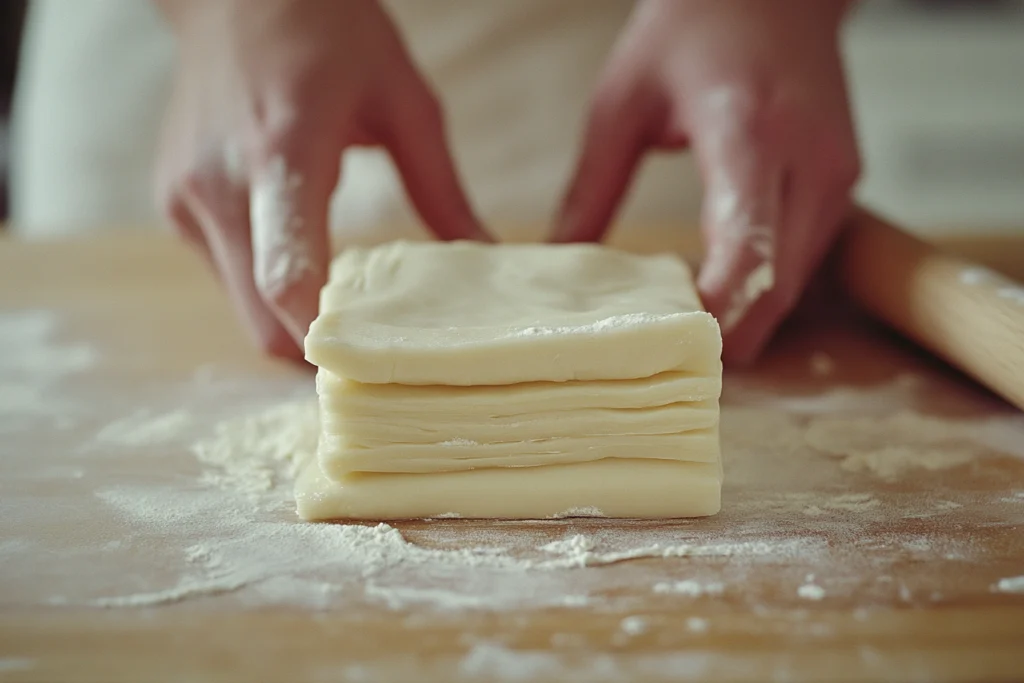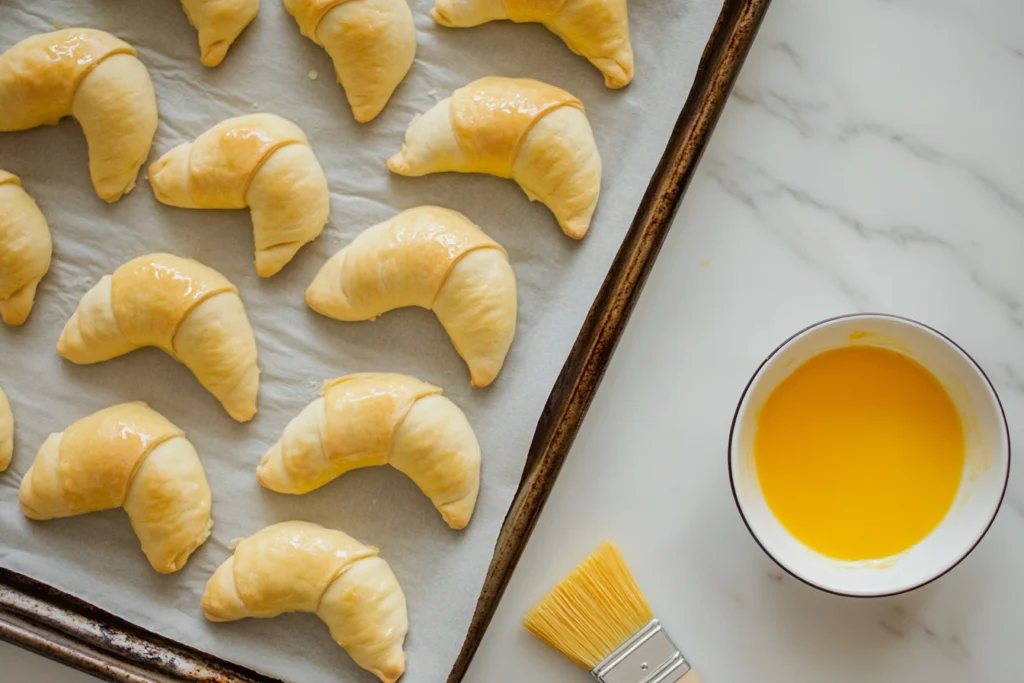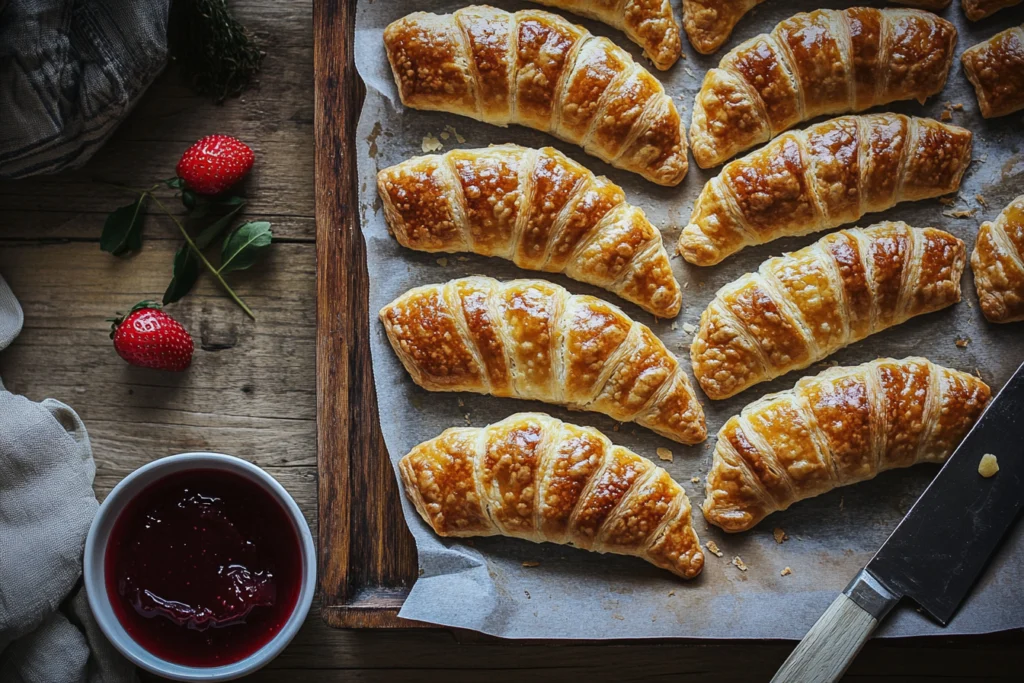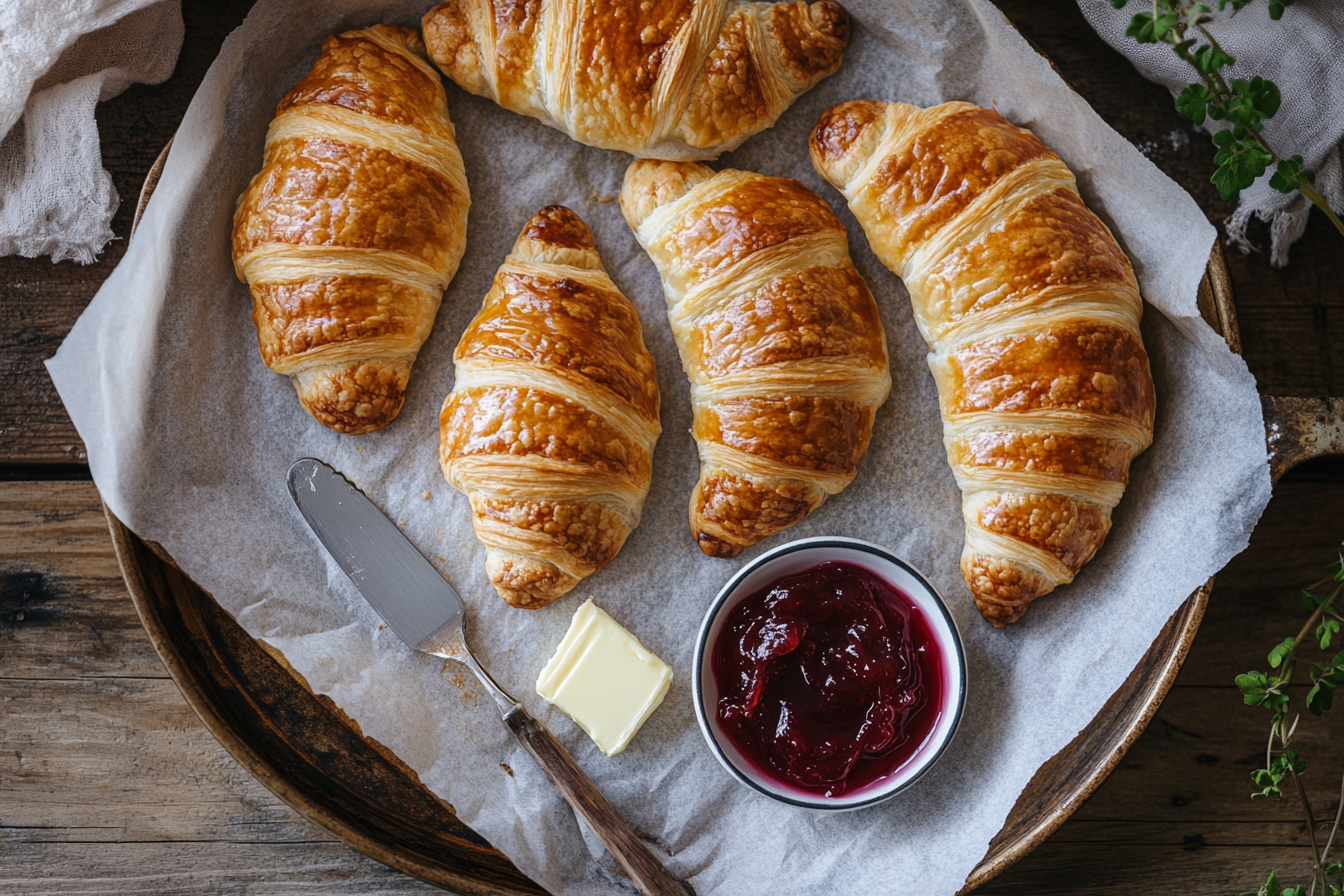Gipfeli, a classic Swiss crescent-shaped pastry, is a delightful treat enjoyed for breakfast across Switzerland. Light, flaky, and less buttery than croissants, these pastries are perfect for pairing with coffee, jam, or fruit. In this article, we’ll take you through a detailed homemade Gipfeli recipe, along with tips for achieving the perfect texture, variations to try, and serving ideas. If you love flaky breakfast treats, this recipe is a must-try! For more delicious baked pastries for breakfast, check out our matcha brownies recipe.

Gipfeli (Swiss Crescent-Shaped Pastries) and Bernese Oberland, Switzerland
- Total Time: 1 hour 20 minutes
- Yield: 12 pastries 1x
Description
A classic Swiss breakfast pastry, Gipfeli is light, flaky, and perfect with coffee, jam, or savory fillings. Less buttery than croissants, it’s a Swiss favorite.
Ingredients
- 500g all-purpose flour
- 7g active dry yeast
- 250ml warm milk (~105°F/40°C)
- 50g sugar
- 1 tsp salt
- 250g cold unsalted butter, cut into pieces
- 1 beaten egg mixed with 1 tbsp milk (for egg wash)
Instructions
- Heat the milk to ~105°F (40°C). Mix with sugar and yeast. Let sit for 5–10 minutes until frothy.
- Combine flour, salt, and yeast mixture in a stand mixer. Knead for 5–7 minutes until smooth. Wrap and chill for 30 minutes.
- Roll chilled dough into a rectangle. Spread butter on two-thirds. Fold into thirds. Turn 90°, roll and fold again. Chill between folds. Repeat 3 times total.
- Roll dough to ¼-inch thickness. Cut into 5-inch base triangles. Slit the base and roll tightly into crescents.
- Place on parchment-lined baking sheet. Cover with damp towel. Let rise at room temperature 30–60 minutes.
- Preheat oven to 400°F (200°C). Brush with egg wash. Bake 5 minutes at 400°F, then 10–15 minutes at 375°F (190°C) until golden brown.
Notes
Use cold butter and chill between folds to ensure flakiness. Handle dough gently to preserve layers. Enjoy plain or with jam, cheese, or chocolate.
- Prep Time: 1 hour
- Cook Time: 20 minutes
- Category: Breakfast
- Method: Baking
- Cuisine: Swiss
Nutrition
- Serving Size: 1 pastry
- Calories: 270
- Sugar: 3g
- Sodium: 150mg
- Fat: 14g
- Saturated Fat: 9g
- Unsaturated Fat: 4g
- Trans Fat: 0g
- Carbohydrates: 30g
- Fiber: 1g
- Protein: 5g
- Cholesterol: 45mg
Keywords: gipfeli, swiss pastry, crescent roll, breakfast, flaky pastry
What Makes This Swiss Gipfeli Recipe Special?
To start with, Gipfeli is a Swiss crescent-shaped pastry that is often compared to croissants, but with notable differences. While croissants are known for their rich, buttery layers, Gipfeli is much lighter, making it ideal for those who prefer a more subtle flavor. Moreover, the Swiss Gipfeli strikes the perfect balance between flaky and soft, with just enough crispiness on the outside to make every bite satisfying.
In contrast to French croissants, Gipfeli contains less butter, which gives it a slightly drier and crispier texture. Additionally, it is less sweet than the Italian cornetto, making it versatile enough to pair with both savory and sweet toppings. For instance, you can enjoy it plain with butter and jam for a quick breakfast, or elevate it with savory fillings like cheese and ham for a heartier option.
What makes Gipfeli even more special is its simplicity. It relies on a few high-quality ingredients, but the magic lies in the laminated dough process. This technique, which involves folding butter into the dough repeatedly, creates the delicate, flaky layers that make Gipfeli unique. Without a doubt, mastering this process will allow you to experience the authentic flavor of Swiss breakfast pastries right at home.
Discover why this Swiss Gipfeli recipe is a lighter, flakier alternative to croissants. Learn how to achieve the perfect texture with simple ingredients.
The Cultural Connection about Gipfeli recipe: Bernese Oberland, Switzerland
Now, let’s dive into the inspiration behind Gipfeli. The Bernese Oberland region in Switzerland is a place of unparalleled natural beauty. Surrounded by the majestic Alps, tranquil lakes, and charming villages, it is no wonder that this region has inspired countless culinary delights, including Gipfeli.
For example, imagine waking up in a cozy chalet in the Bernese Oberland, with the crisp mountain air filling your lungs and a plate of freshly baked Gipfeli waiting on the table. The simplicity and charm of the region are reflected in this pastry, making it more than just a breakfast item—it’s an experience.
During my travels through Bernese Oberland, I vividly remember enjoying Gipfeli during a scenic boat ride on Lake Brienz. The serene waters, dotted with reflections of the surrounding mountains, created the perfect setting to savor the delicate, buttery pastry. Moreover, the locals shared stories of how Gipfeli has been a breakfast tradition for generations, often served with Swiss butter, fruit preserves, and coffee.
It’s clear that Gipfeli is more than just food—it’s a reflection of Swiss culture. The pastry represents the region’s love for simplicity, quality, and tradition. Whether you’re savoring it in a Swiss bakery or recreating the experience at home, Gipfeli connects you to the beauty of Bernese Oberland in a truly delicious way.
Gipfeli recipe vs. Croissants: What’s the Difference?
At first glance, Gipfeli and croissants appear almost identical. However, there are significant differences that set them apart. First and foremost, Gipfeli contains less butter compared to croissants. Because of this, Gipfeli is lighter and crispier, while croissants have a richer, more indulgent texture.
Additionally, croissants tend to emphasize pronounced layers and a flaky texture, whereas Gipfeli strikes a balance between flaky and soft. For this reason, Gipfeli is often preferred for everyday breakfasts, as it feels less decadent. Another difference lies in the taste. While croissants highlight the buttery flavor, Gipfeli has a more neutral profile. This versatility allows it to pair beautifully with both sweet toppings, such as jam or honey, and savory options like ham and cheese.
Overall, if you’re looking for a lighter, less buttery alternative to croissants, Gipfeli is the perfect choice. It embodies the simplicity of Swiss cuisine while still delivering that satisfying flaky texture. Understanding these differences will help you appreciate why the traditional Gipfeli recipe has stood the test of time in Swiss households.
Traditional Gipfeli recipe: Ingredients You’ll Need
To create the perfect homemade Gipfeli, you need high-quality ingredients and a few essential tools. Each ingredient plays a vital role in achieving the right texture and flavor, so it’s important to measure everything precisely.
Ingredients to make Gipfeli recipe:
- All-purpose flour for Gipfeli – 500g (ensures the dough structure is light and airy)
- Active dry yeast – 7g (helps the dough rise properly)
- Warm milk for yeast activation – 250ml (~105°F/40°C, perfect for activating yeast)
- Sugar – 50g (adds just the right amount of sweetness)
- Salt – 1 tsp (balances all the flavors)
- Cold unsalted butter – 250g, cut into small pieces (key for the laminated dough process)
- Egg wash for Gipfeli – 1 beaten egg mixed with 1 tbsp milk (for a golden, glossy crust)
Tools:
- Stand mixer for efficient dough preparation
- Rolling pin for laminated dough
- Parchment paper for baking
- Baking sheet for Gipfeli
- Measuring tools to ensure accuracy
These simple yet essential ingredients form the foundation of the best Gipfeli recipe. Additionally, using cold butter and the proper tools will make it easier to achieve the pastry’s delicate flakiness.
For more homemade bakery recipes for your kitchen, don’t miss our guide on churro cheesecake bars.
Step-by-Step Guide to Homemade Gipfeli recipe
Master this easy homemade Gipfeli recipe with a detailed breakdown of dough preparation, the laminated dough process, and shaping crescent rolls.
Step 1: Activate the Yeast
To begin, heat the milk to around 105°F (40°C). It should be warm but not too hot, as excessive heat can kill the yeast. Next, combine the warm milk, sugar, and active dry yeast in a bowl. Stir gently and let it sit for about 5-10 minutes. During this time, the mixture will become frothy, which indicates that the yeast is activated and ready to use.
Step 2: Prepare the Dough
In a stand mixer, combine the all-purpose flour, salt, and the activated yeast mixture. Mix on low speed until the dough begins to form. Then, knead the dough for about 5-7 minutes until it becomes smooth and elastic. Once ready, wrap the dough in plastic wrap and refrigerate it for at least 30 minutes. Chilling the dough at this stage is crucial because it ensures the butter won’t melt during the lamination process.

Step 3: Laminate the Dough
Laminating the dough is what creates the flaky layers in Gipfeli. First, roll the chilled dough into a large rectangle on a lightly floured surface. Next, place the cold butter pieces evenly over two-thirds of the dough. Fold the dough into thirds, like a letter, to enclose the butter. Turn the dough 90 degrees, roll it out again, and repeat the folding process.
To keep the butter firm, chill the dough for 20-30 minutes between each fold. Repeat this process 3 times to create the distinct laminated layers. This step may take time, but it is essential for achieving the signature flakiness of Swiss Gipfeli.
For a step-by-step guide to creating flaky pastries, check out this helpful article on Thai coconut curry chicken.
Step 4: Shape the Gipfeli
Once laminated, roll the dough into a large rectangle about ¼-inch thick. Cut the dough into triangles, ensuring each one has a base of approximately 5 inches. Next, make a small slit at the base of each triangle and roll it tightly from the base to the tip. To finish, slightly bend the tips inward to form the classic crescent shape.
Step 5: Proof the Dough
Place the shaped Gipfeli on a parchment-lined baking sheet, leaving space between each piece. Cover them with a damp towel and allow them to proof at room temperature for 30-60 minutes. During this time, the dough will puff up slightly but should not double in size.
Step 6: Bake the Gipfeli
Preheat your oven to 400°F (200°C). Brush the proofed Gipfeli with egg wash to give them a beautiful golden sheen. Bake for 5 minutes at 400°F, then lower the temperature to 375°F (190°C) and continue baking for another 10-15 minutes. Once they are golden brown and flaky, remove the Gipfeli from the oven and allow them to cool slightly.

Tips for the Best Swiss Breakfast Pastries
- Use cold butter to ensure flaky layers.
- Don’t skip chilling between folds – this preserves the laminated dough.
- Handle the dough gently to avoid pressing out the layers.
- If the dough feels sticky, dust with a little extra flour while rolling.
Delicious Variations of Swiss Gipfeli Recipe
Get creative with these tasty Gipfeli variations:
- Sweet Gipfeli: Fill with strawberry jam or glaze with honey.
- Savory Gipfeli: Add ham and Gruyère cheese before shaping.
- Chocolate-filled Gipfeli: Place a chocolate baton inside each triangle.
- Nutty Gipfeli (Nussgipfel): Use hazelnut or almond paste for a crunchy filling.
Serving Suggestions for Gipfeli recipe
Pair your Gipfeli with these breakfast favorites:
- Gipfeli with coffee or tea for a classic European breakfast.
- Fresh fruit like berries or citrus slices.
- Scrambled eggs for a savory twist.
- Smoothies for a healthy brunch option.
For more delicious baked pastries for breakfast, check out our step-by-step guide to creating flaky pastries.

Why Gipfeli is the Perfect Swiss Breakfast Pastry
Gipfeli combines simplicity, lightness, and versatility, making it an ideal choice for breakfast or brunch. Whether you enjoy it plain or filled, its flaky texture and delicate flavor are a true celebration of Swiss baking.
Conclusion about Gipfeli recipe
Gipfeli is more than just a breakfast pastry—it’s a symbol of Swiss tradition, simplicity, and culinary craftsmanship. Whether you are
inspired by the serene landscapes of Bernese Oberland or simply looking to enjoy a flaky, buttery treat, this Gipfeli recipe offers the perfect solution. With its light texture, versatile flavor, and endless pairing options, Gipfeli has something for everyone. So, gather your ingredients, embrace the art of laminated dough, and bring a taste of Switzerland into your kitchen. You’ll not only create delicious pastries but also unforgettable moments around the table with loved ones.
Frequently Asked Questions About Gipfeli recipe
1. What are the ingredients in a croissant?
A traditional croissant requires simple ingredients, including:
All-purpose flour – provides structure.
Yeast – for leavening and creating a light, airy texture.
Cold unsalted butter – essential for laminating the dough and achieving flakiness.
Sugar – for a hint of sweetness.
Salt – balances the flavors.
Milk or water – activates the yeast and forms the dough.
Egg wash – brushed on before baking to achieve a golden, shiny crust.
These ingredients are combined using a lamination process, where butter is folded into the dough multiple times to create delicate, flaky layers.
2. What is the secret to a good croissant?
The key to making perfect croissants lies in three important factors:
Cold butter: Ensuring the butter remains cold during the lamination process creates the distinct flaky layers. If the butter melts into the dough, the layers will disappear.
Proper resting and proofing: Allowing the dough to rest between each fold and giving it enough time to proof before baking ensures a light and airy texture.
Precision: Following exact measurements, rolling evenly, and maintaining consistent thickness throughout the process help achieve uniform croissants.
Additionally, baking at the correct temperature is essential to get a crisp, golden exterior and tender interior.
3. What is the recipe of Mohallabia?
Mohallabia, also known as Mahalabia, is a popular Middle Eastern milk pudding. It is simple, creamy, and flavored with fragrant ingredients like rosewater or orange blossom water.
Ingredients:
4 cups milk
5 tbsp cornstarch (to thicken the pudding)
½ cup sugar
1 tsp rosewater or orange blossom water
Chopped nuts (like pistachios) for garnish
Instructions:
In a saucepan, combine 3 cups of milk and sugar. Heat over medium flame until the milk is warm but not boiling.
In a separate bowl, mix the cornstarch with 1 cup of cold milk until fully dissolved.
Gradually add the cornstarch mixture to the saucepan, stirring constantly to prevent lumps.
Continue cooking and stirring until the mixture thickens to a pudding-like consistency.
Remove from heat and add rosewater or orange blossom water for fragrance.
Pour the pudding into serving bowls and let it cool.
Garnish with chopped pistachios or almonds before serving.
Mohallabia is best served chilled and can be enjoyed as a light dessert after a meal. Its creamy texture and subtle flavor make it a favorite in Middle Eastern cuisine.

